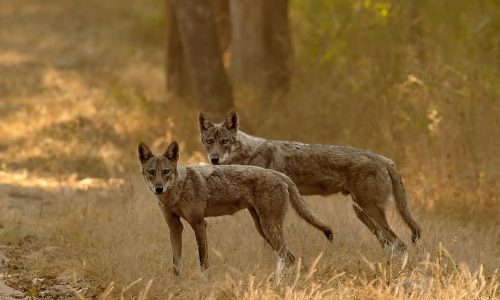ASIAN WILD DOG
The Asian Wild Dog or the Indian Dhole is an ancient animal that has been recorded since 1794 by many travelers all around the world especially in Central Asia. They are regarded as the ice age survivor. These unique carnivores are also found in plenty in India, in various national parks and forested jungles. In many physical appearances, it resembles partly like red fox and partly like dog. However, it does not have the canine characteristics of usual three molars, but only has two molars. They are the only member of the genus Cuon. They are very highly sociable animal and hunt in huge herds and packs, with an excellent communication system.
ASIAN WILD DOG FACTS
| Scientific Name | Cuon alpinus |
|---|---|
| Status | Endangered |
| Species | C. alpinus |
| Diet | Carnivore |
| Lifestyle | Highly sociable |
| Lifespan | 15 years in captivity |
| Gestation Period | 63 days |
| Breeding Season | November to April |
| Sexual Maturity | 1 year old |
| Litter Size | 1 to 12 pups |
Physical Characteristics: They have a physical resemblance to the African Wild Dog and sometimes also looks like a red fox also. They weigh about 12 to 20 kg… The total body length is about 90 cm and the total height up to shoulder is about 50 cm. they have a moderately long tail of about 45 cm in length. The dorsal body fur is red to brown in color while the fore neck, chest and stomach are white colored. They have a large ear which is rounded and give their characteristic look. It can be compared to a cat on the account of it possessing long backbone and slim and slender limbs. Compared to other canines, the dhole has many missing characteristics. It has only one cusp as opposed to 2 to 4 in usual canines. “Compared to a tiger, a Dhole is not very ‘sexy,’” said Kate Jenks, a conservation biologist. This is the main reason that they tend to get neglected by the wildlife enthusiasts who are more interested in tigers and lions.
Habit: Dholes are social animals who love to hunt in herd. They are very efficient predators. They are even reported to hunt down tigers in huge packs. Their common preys are deer, sambar, wild boar etc. They have a very complex and an elaborate communication system. They produce a characteristic whistle like coo – coo in order to co – ordinate the packs while moving through jungles and keeping them intact. They produce plenty of other sounds also like whining, screaming, chattering, screaming like “ka-ka-ka”. They also have very amusing behavioral characters. When they are playful in mood, they open their mouth with retracted lip and their tail is drooped down in submission. If a Dhole is threatening, then it puckers its mouth forward in a growling snarl and the hairs on their back are raised. The scared dhole had his ears lowered down and his tail curled up in fear.
Habitat: The Dholes generally love to live in the forested jungles of deciduous trees, semi deciduous trees, and tropical rain forests. However, they can also survive in the open areas like meadows and steppes of Kashmir Region. They have a very good adaptability and hence, they can also survive in the dense alpine forests of the mountain regions. In the candid family, the Dholes have the largest range of climate adaptability, from freezing cold to tropical climate.
Distribution: In India, Dhole is present in the Central Indian Highlands, The Western Ghats, Eastern Ghats, and the jungles of North – East India. They may be also found in small number in the area of Ladakh.
Threats: The main threat for the declining population pod dholes in India is the increasing population of humans. Due to this, encroachment of their natural habitat is being taken place due to which there is an animal – human conflict. The humans have disturbed the food chain by killing many preys belonging to Dhole leading to food scarcity. The humans are also making them prone to exposure to deadly domestic diseases of pet dogs.
Conservation: In India the Dhole is protected under the Schedule 2 of the Wildlife Protection Act of 1972. Since then, it is illegal to hunt and kill dhole. The Dhole conservation breeding center was sanctioned by the Government in 2014, in the Indira Gandhi Zoological Park in Vishakhapatnam. The Indian Government has been pressurized in carrying out the rules strictly when dholes are killed by villagers, when they are perceived as threat to their livestock.
How do you think we can improve the facts and information provided for ‘Asian Wild Dog / Indian Dhole’ on this page? Tell us at delhi@groowynd.com
Recommended Tours
Kerala – Karnataka Tour Package
DURATION: 14 Days | PLACES: Bangalore (1 Day), Nagarhole (2), Bandipur (2), Mudumalai (1), Eravikulam (2), Periyar (2), Kumarakom (1), Alleppey (1), Kochi (1)
Read More



